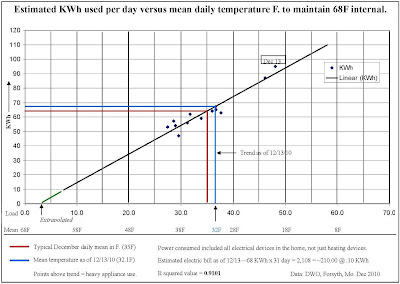Last December, I used 1,629 kilowatt hours of power to keep my home warm and to run my assorted appliances and electronic gadgets. December 2010 was a perfectly normal month from the standpoint of outside temperatures. The mean was 35.1F versus an historical average of 35F. That translated into an average daytime high of about 45F and a low somewhere below freezing. I own a heat pump and as you may know, they struggle to work at any temperature much be 32F. So, for most of the month, the ‘emergency’ mode went into effect whereby heating elements were turned on to make up for what the heat pump could not provide.
Last year, however, I made some changes both physically (installed plastic over the windows) and in terms of how I used power. I employed the aid of a device called the Total Energy Detective (T.E.D.) to help me monitor my power us real time. I also set a budge of no more that 52 kilowatt hours of power per day and that worked out pretty well. Whenever I could, I would avoid appliances like the stove in favor of the more energy efficient microwave. I used space heaters deployed in select rooms to facilitate point of use heating. I made sure to run my dishwasher less often as I did the washing machine (no more partial loads of laundry). I was on a budget and I stuck to it!
The end result was a 34% savings in 2010 over 2009! That lower electric bill was a real blessing during a month when all my other bills were high! Now, this year, I’m hoping to improve on 2010 and have reduced my electric budget by another 25%. That translates out to 52-13 kWh less power a day or about 39 KWh. If I get lucky this coming December will be a little bit warmer than the average of 35F. If that happens I’m sure I can make this work. Otherwise, if it gets colder than normal, I’ll certainly have a challenge on my hands.
If you’re wondering how I did for November 2011 – it was a 34% decrease!
























